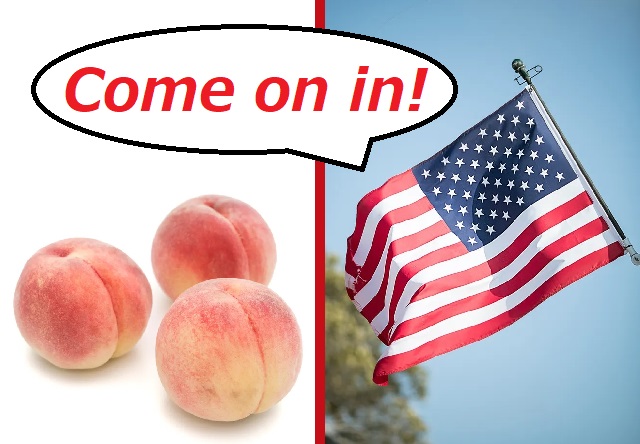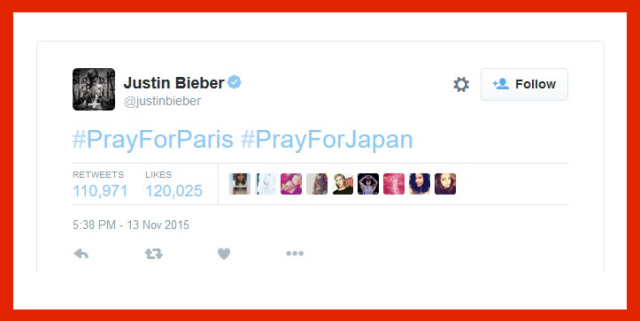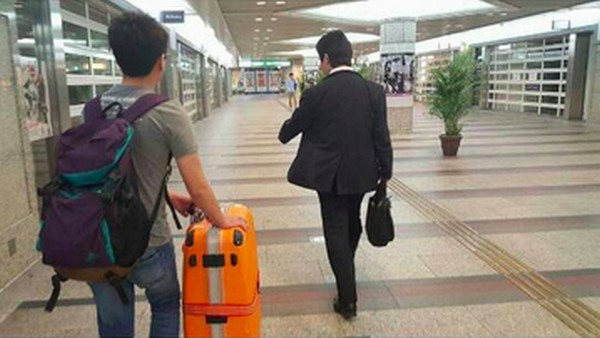A decade after the 3-11 earthquake, tsunami, and nuclear incident, all Japanese produce from the affected areas has an open path to the U.S.
Tohoku Earthquake
On the morning of Saturday, November 14, many Japanese Beliebers, along with some Non-Beliebers and Agnobiebers, awoke and checked into Twitter as usual only to find the famous Canadian pop star declaring that he was praying for their souls right alongside those of the people of Paris.
Confused and a little concerned, I—a card-carrying Agnobeiber—showed the above tweet to my coworkers, all of whom were equally baffled as to why Justin Bieber should be praying for them, considering nothing out of the ordinary happened here in Japan.
Many of us may have experienced getting lost in a foreign land and needing assistance from a local person. In most cases, we thank the kind soul who lent us a helping hand, but have you ever received thanks from the person who helped you instead?
A Taiwanese tourist recently shared that during his visit to Osaka, he sought help from a Japanese man, who not only spent over 30 minutes making sure the foreign visitors made it safely to their destination, he even thanked the tourists for their help instead. Find out why after the break!
“Customer growth is stronger now compared to immediately after the quake,” said G, an organized crime group affiliate familiar with the illegal drug market. The Great Hanshin-Awaji Earthquake of 1995 proved there was a good post-disaster market for illegal drugs among temporary housing residents and others suffering from post-traumatic stress disorder (PTSD). As a result, when the Great East Japan Earthquake struck, dealers from major urban centers swiftly loaded up and headed north to disaster-afflicted areas in the Tohoku region in search of quick profits.
According to G, “First on the scene were the stimulant drug pushers who began selling out of their cars on the back streets and in pachinko (pinball) parlor parking lots. Customers were wide-ranging, from high school students and young bar hostesses to grandfathers and grandmothers. Inferior grades of speed which couldn’t be sold in Tokyo and Osaka were offloaded there.”
Read More
It wasn’t just the earthquake or tsunami of March 11, 2011 that shattered the town of Namie in Fukushima Prefecture, it was the subsequent radiation. Slowly creeping across the once fertile land, it ripped families from their homes and banished them to evacuation centers elsewhere. Today, nearly two years after the worse nuclear disaster since Chernobyl, the entire 86 square miles of Namie have been declared uninhabitable due to high levels of radioactive cesium. Even if families wanted to return, they can’t.
Amid this tragic loss, Google Street View is giving the people of Namie a chance to visit the town they were forced to flee.
Japan’s Ministry of Finance has just announced the chosen designs for coins commemorating the reconstruction efforts for the Great East Japan Earthquake that rocked the northern area of Tohoku on March 11, 2011.
A premium gold coin with a face value of 10,000 yen (US $127) and a premium silver coin with a face value of 1,000 yen (US $12.75) are schedule to be produced in 2015. Most are engraved with beautiful symbols of Japan, but does one of them look a little funny to you? Read More
The city of Rikuzentakata was thoroughly devastated by the March 11 tsunami. However, following the destruction a single 27 meter 200 year-old pine tree was left standing, the sole survivor of a forest of 70,000 trees along the coast line. The tree had become a symbol of hope for the country and local government vowed to protect it at all costs.
However, for the past year the tree’s health had been fading fast and it doesn’t have much longer to live. And so the city’s government is going to enact a preservation scheme which is rubbing Japanese netizens the wrong way due to its 150,000,000 yen (US$1.9M) price tag.






 10 times to avoid traveling in Japan in 2026
10 times to avoid traveling in Japan in 2026 Our 52-year-old pole dancing reporter shares his tips for achieving your New Year’s exercise goal
Our 52-year-old pole dancing reporter shares his tips for achieving your New Year’s exercise goal Say hello to Japan’s new stationmaster cat!【Video】
Say hello to Japan’s new stationmaster cat!【Video】 Bamboo trees vandalized near Kyoto’s Fushimi Inari shrine, foreign graffiti prevalent
Bamboo trees vandalized near Kyoto’s Fushimi Inari shrine, foreign graffiti prevalent Starbucks Japan releases new Frappuccino and latte for Valentine’s Day
Starbucks Japan releases new Frappuccino and latte for Valentine’s Day Umamusume anime girl plushie recalled for having parts she absolutely should not have【Pics】
Umamusume anime girl plushie recalled for having parts she absolutely should not have【Pics】 A visit to the oldest Yoshinoya chain in Japan for one last beef bowl before it closes for good
A visit to the oldest Yoshinoya chain in Japan for one last beef bowl before it closes for good 10 vegetarian foods you can order at almost any Japanese restaurant
10 vegetarian foods you can order at almost any Japanese restaurant Collect ’em all! New Pokéfuta accessories now available at Village Vanguard
Collect ’em all! New Pokéfuta accessories now available at Village Vanguard Nintendo releases Metroid-shaped ice cube/cooking tray and Samus arm cannon pillow【Pics】
Nintendo releases Metroid-shaped ice cube/cooking tray and Samus arm cannon pillow【Pics】 Japanese beef bowl chain Sukiya’s 2026 Smile Box lucky bag basically pays for itself
Japanese beef bowl chain Sukiya’s 2026 Smile Box lucky bag basically pays for itself Hayao Miyazaki says Happy New Year to Studio Ghibli fans with new art for Year of the Horse
Hayao Miyazaki says Happy New Year to Studio Ghibli fans with new art for Year of the Horse Ramen restaurant’s English menu prices are nearly double its Japanese ones, denies discriminating
Ramen restaurant’s English menu prices are nearly double its Japanese ones, denies discriminating Starbucks Japan ready to get Year of the Horse started with adorable drinkware and plushies【Pics】
Starbucks Japan ready to get Year of the Horse started with adorable drinkware and plushies【Pics】 Top Japanese cosplayer Enako returns to Comiket after 6 years, creates mayhem with admirers
Top Japanese cosplayer Enako returns to Comiket after 6 years, creates mayhem with admirers Cup Noodle tries an authentic Jiro-style ramen, but something’s not quite right
Cup Noodle tries an authentic Jiro-style ramen, but something’s not quite right The best Starbucks Japan Frappuccinos we want to drink again in 2026
The best Starbucks Japan Frappuccinos we want to drink again in 2026 We revisited Sweets Paradise after a decade to see if Japan’s dessert buffet still delivers
We revisited Sweets Paradise after a decade to see if Japan’s dessert buffet still delivers That time Seiji called JASRAC to ask why he didn’t get paid royalties for his song being on TV
That time Seiji called JASRAC to ask why he didn’t get paid royalties for his song being on TV 7-Eleven Japan starts new temporary luggage storage service in over 300 branches
7-Eleven Japan starts new temporary luggage storage service in over 300 branches Disillusionment at Tsukiji’s tourist-target prices led us to a great ramen restaurant in Tokyo
Disillusionment at Tsukiji’s tourist-target prices led us to a great ramen restaurant in Tokyo Starbucks teams up with 166-year-old Kyoto doll maker for Year of the Horse decorations【Photos】
Starbucks teams up with 166-year-old Kyoto doll maker for Year of the Horse decorations【Photos】 Tokyo considering law requiring more trash cans following litter increase in heavily touristed area
Tokyo considering law requiring more trash cans following litter increase in heavily touristed area Tokyo’s Tsukiji sushi neighborhood asks tour groups to stay away for the rest of the month
Tokyo’s Tsukiji sushi neighborhood asks tour groups to stay away for the rest of the month Tokyo event lets you travel back in time, for free, to celebrate 100 years since Showa era start
Tokyo event lets you travel back in time, for free, to celebrate 100 years since Showa era start Japan may add Japanese language proficiency, lifestyle classes to permanent foreign resident requirements
Japan may add Japanese language proficiency, lifestyle classes to permanent foreign resident requirements Lacquerware supplier to emperor of Japan and Pokémon team up for new tableware
Lacquerware supplier to emperor of Japan and Pokémon team up for new tableware Starbucks Japan releases new zodiac chilled cup drink for 2026
Starbucks Japan releases new zodiac chilled cup drink for 2026 Survey asks foreign tourists what bothered them in Japan, more than half gave same answer
Survey asks foreign tourists what bothered them in Japan, more than half gave same answer Japan’s human washing machines will go on sale to general public, demos to be held in Tokyo
Japan’s human washing machines will go on sale to general public, demos to be held in Tokyo We deeply regret going into this tunnel on our walk in the mountains of Japan
We deeply regret going into this tunnel on our walk in the mountains of Japan Studio Ghibli releases Kodama forest spirits from Princess Mononoke to light up your home
Studio Ghibli releases Kodama forest spirits from Princess Mononoke to light up your home Major Japanese hotel chain says reservations via overseas booking sites may not be valid
Major Japanese hotel chain says reservations via overseas booking sites may not be valid Put sesame oil in your coffee? Japanese maker says it’s the best way to start your day【Taste test】
Put sesame oil in your coffee? Japanese maker says it’s the best way to start your day【Taste test】 No more using real katana for tourism activities, Japan’s National Police Agency says
No more using real katana for tourism activities, Japan’s National Police Agency says Starbucks Japan reveals new sakura drinkware collection, inspired by evening cherry blossoms
Starbucks Japan reveals new sakura drinkware collection, inspired by evening cherry blossoms Updated cherry blossom forecast shows extra-long sakura season for Japan this year
Updated cherry blossom forecast shows extra-long sakura season for Japan this year Human washing machine pods coming to Japanese hotels【Photos】
Human washing machine pods coming to Japanese hotels【Photos】 Umamusume anime girl plushie recalled for having parts she absolutely should not have【Pics】
Umamusume anime girl plushie recalled for having parts she absolutely should not have【Pics】 A visit to the oldest Yoshinoya chain in Japan for one last beef bowl before it closes for good
A visit to the oldest Yoshinoya chain in Japan for one last beef bowl before it closes for good 10 vegetarian foods you can order at almost any Japanese restaurant
10 vegetarian foods you can order at almost any Japanese restaurant Collect ’em all! New Pokéfuta accessories now available at Village Vanguard
Collect ’em all! New Pokéfuta accessories now available at Village Vanguard Nintendo releases Metroid-shaped ice cube/cooking tray and Samus arm cannon pillow【Pics】
Nintendo releases Metroid-shaped ice cube/cooking tray and Samus arm cannon pillow【Pics】 Japanese company trips – Workers “absolutely hate” them, so why do they still happen?
Japanese company trips – Workers “absolutely hate” them, so why do they still happen? Village Vanguard’s “dangerous” lucky bag promises thrilling highs and miserable lows
Village Vanguard’s “dangerous” lucky bag promises thrilling highs and miserable lows Is this common Japanese phrase for “goodbye” the reason for Japan’s crazy overtime hours?
Is this common Japanese phrase for “goodbye” the reason for Japan’s crazy overtime hours? 7-Eleven Japan’s ramen-cooking robot whipped us up a bowl of noodles【Taste test】
7-Eleven Japan’s ramen-cooking robot whipped us up a bowl of noodles【Taste test】 Is it rude to sing along at concerts in Japan? We ask a pro musician for his take
Is it rude to sing along at concerts in Japan? We ask a pro musician for his take Private booths are coming to Japan’s Shinkansen bullet trains even sooner than we’d thought【Video】
Private booths are coming to Japan’s Shinkansen bullet trains even sooner than we’d thought【Video】 Japanese beef bowl chain Sukiya’s 2026 Smile Box lucky bag basically pays for itself
Japanese beef bowl chain Sukiya’s 2026 Smile Box lucky bag basically pays for itself